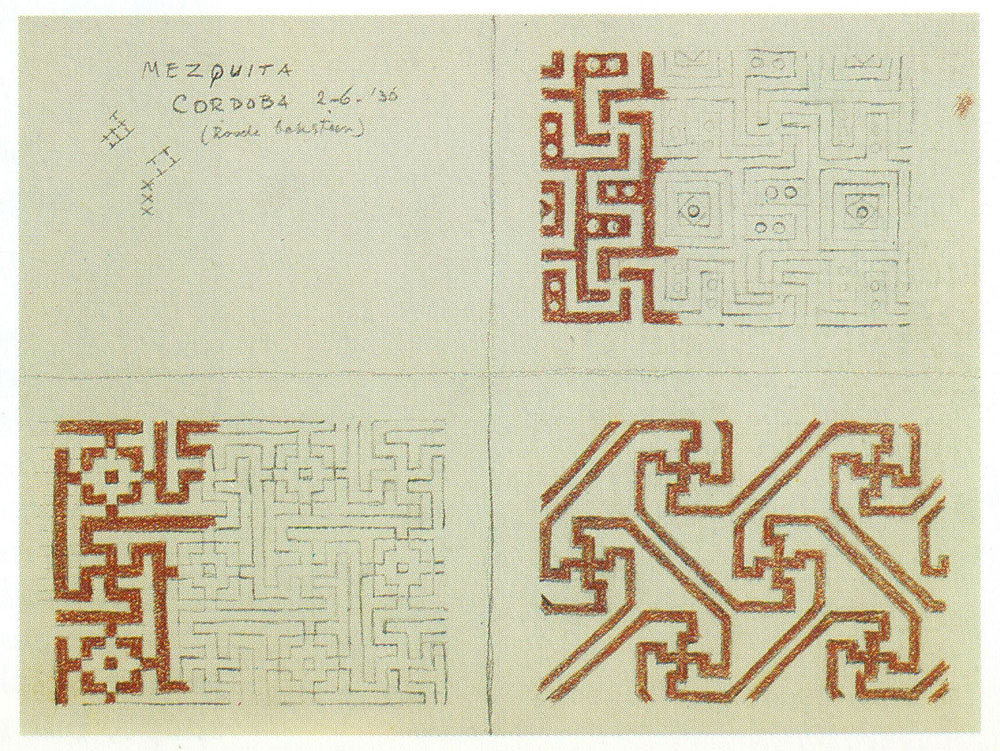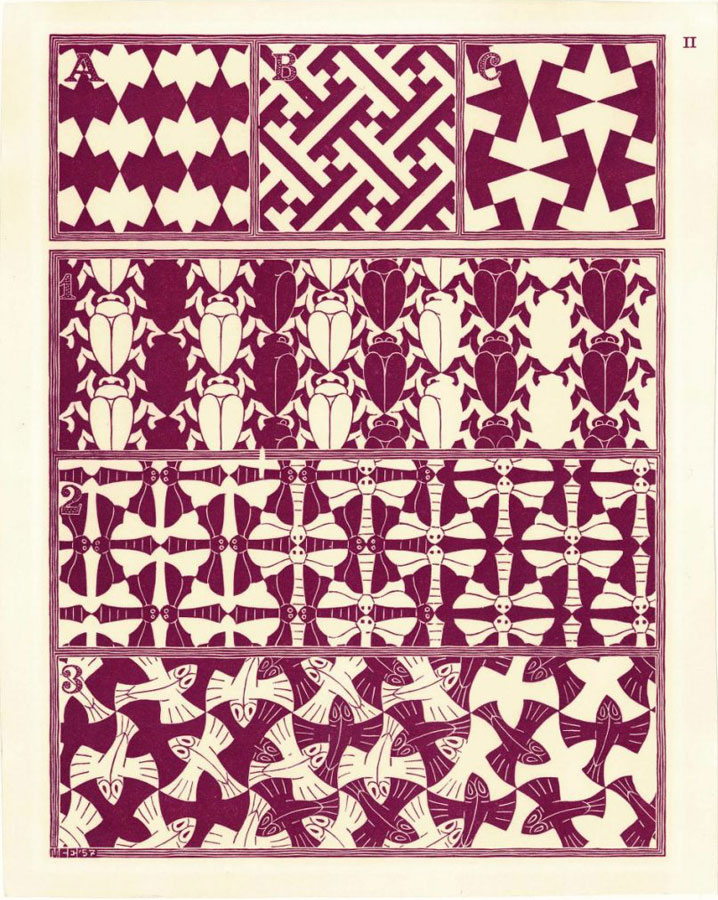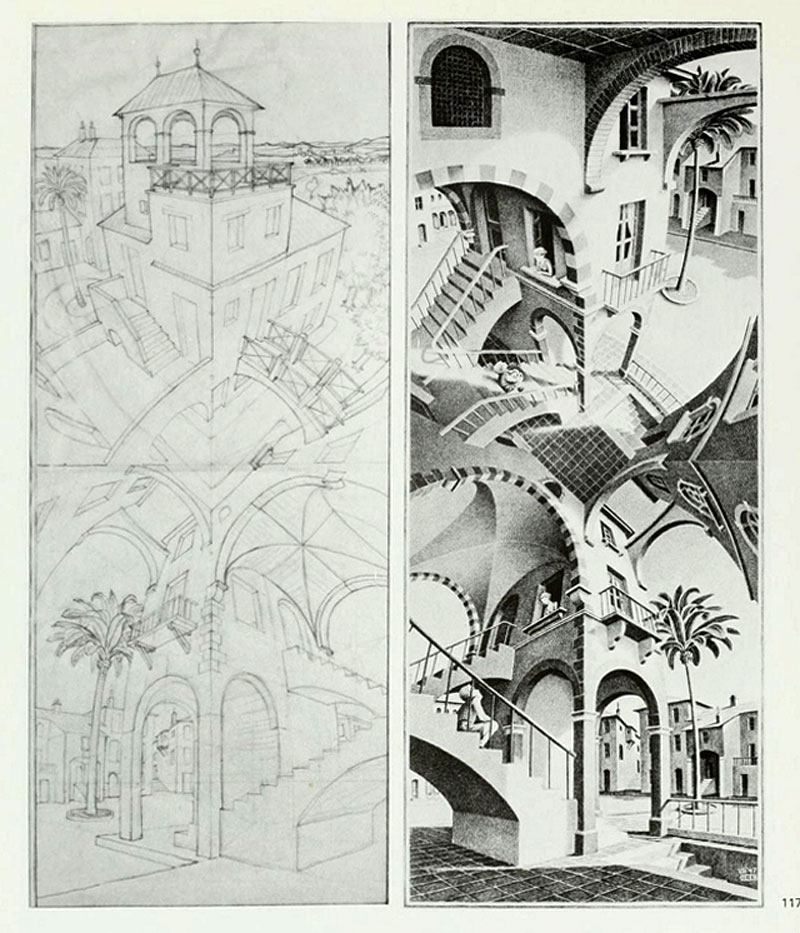What is it that fascinate us so much about M.C. Escher? His impossible paintings and surreal mosaics seem to lack a expire date. There are a millions replicas of his drawings circulating the web, especially those reflecting his tours around Córdoba and Granada. Maurits Cornelis Escher, better known as M.C. Escher, traveled to Spain for the first time in 1926 and visited the Alhambra of Granada. He took many notes during his stay there and made sketches of its famous mosaics.
Escher worked very hard to breathe a rhythmical structure into his drawings trying to emulate that of the tessellations in the Alhambra, apparently with little success. Using his own words, he could only managed to “draw deformed and hideous animals that, to his disgust, half were walking the other way round”.
After several disappointments, Escher found himself on the verge of a dead end street. Ten years passed and not a word on the regular partitioning of planes was said, it had became a taboo.
In 1936, however, Escher returned to Spain with his wife Jetta. This second tour carved deeper the Moorish print on his work. He went back to visit the Alhambra and kept studying its ornaments, but he also visited Córdoba. There he made further sketches of the tessellations in the walls of the Mezquita. It is more than likely that his drawing of a patio with a palm tree was inspired on patios from Córdoba. This second tour was a milestone in Escher’s repetitive partitioning of planes. His discovery of the Moorish geometrical ornamentations in Spain came to obsess him and then later constituted one the foundations of his maturity works; the works that made him the most popular European illustrator ever.
This second tour was not all that pleasant, a misunderstanding got him in jail. He was drawing sketches of the old walls of Cartagena and was seen by some policemen that took him for a foreign spy peaking into the defense infrastructure of the city. He landed in jail for a couple hours, not before his sketches were taken away. When they finally freed him he had lost his ship home and he would never recover those sketches.
None of the books on ornaments and mathematical essays he read he could understand. Only the illustrations, made from previous sketches, were of any use to him. And then, he realized what he was looking for all that time. In 1937 he cleared his mind and defined the practical system with which he would later, between 1941 and 1942, write down. Although he was already putting it into practice in his drawings of cycles and metamorphosis.
His most popular works, impossible figures, reticulated backgrounds and landscapes with repetitive patterns and imaginary worlds, have been replicated over and over again in books and magazines of all sort. In a way, he has come to be one of the most referenced artists in pop culture throughout the XXth century (and also our young XXIst century). Yet another great cultural figure that relied on Spain, Andalucía and, especially, Córdoba, to create.
M.C. ESCHER’S DRAWINGS OF CÓRDOBA
Above, a rare drawing of the arcs of the Mezquita that are exhibited in the museum the artist has in The Hague.
La Mezquita, Córdoba. 1936
Black an white crayons, 480x625 mm.
Dated and inscribed: la mezquita de córdoba 2-6-1936

Raw sketch taken in Córdoba that resembles the tessellations in red and ochre decorating one of the exterior doors that guard the temple. It belongs to the archives in the Escher museum in The Hague.

A page from his study on regular division of the plane. At the top there are some tessellations. The center reproduces the gates of the Mezquita.

Up and down, lithography (1947)
This famous lithography, of which here we have a previous sketch, feels just like Córdoba. Not only because it is a patio, but it also reproduces the alternating of color of the arcs inside the Mezquita. Finally, the sketch has the typical tower of an Andalusian house.



